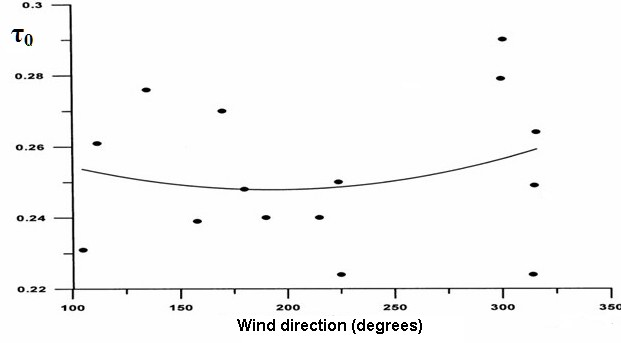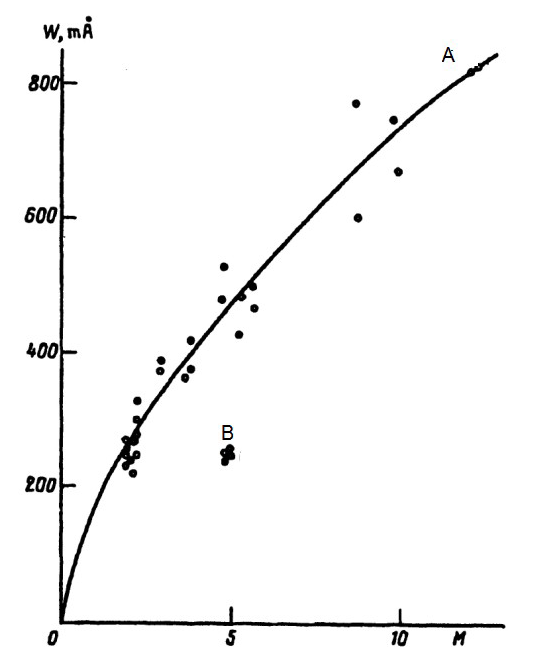-
Paper Information
- Previous Paper
- Paper Submission
-
Journal Information
- About This Journal
- Editorial Board
- Current Issue
- Archive
- Author Guidelines
- Contact Us
International Journal of Ecosystem
2012; 2(2): 25-31
doi: 10.5923/j.ije.20120202.04
The Astrophysical Methods for Long-Term Monitoring of the CO2 Content in the Earth Atmosphere
A. I. Khlystov , B. V. Somov
Sternberg State Astronomical Institute, Lomonosov Moscow State University (MSU), Moscow, 119991, Russia
Correspondence to: A. I. Khlystov , Sternberg State Astronomical Institute, Lomonosov Moscow State University (MSU), Moscow, 119991, Russia.
| Email: |  |
Copyright © 2012 Scientific & Academic Publishing. All Rights Reserved.
We alert the astronomers carrying high-resolution observations of the Sun to a possibility to study global changes in the composition of the Earth atmosphere and other atmospheric characteristics using spectra containing telluric lines. This possibility is illustrated by solar observations carried in Moscow in visible and near infrared spectrum. A comparison of equivalent widths O2 (λ6295 Å) and CO2 (λ20,700 Å) lines, recorded with a spectrograph on the large vertical solar telescope ATB-1 at the Sternberg State Astronomical Institute from 1969 to 2007 reveals that during this period oxygen content in atmosphere above Moscow remained constant (within the limits of observational accuracy) whereas the carbon dioxide content increased significantly.
Keywords: Greenhouse gases, carbon dioxide, CO2 content
Article Outline
1. Introduction
- A problem of global warming due to the greenhouse effect appeared at the end of the 20th century and till now it is a serious environmental issue. Global warming is defined as the warming of the Earth by greenhouse gases emitted into the atmosphere naturally or through human activities. The greenhouse effect as the process by which some of outgoing radiative energy is transferred back to the surface and heats the Earth, was discovered by Joseph Fourier in 1824, and first investigated quantitatively by Svante Arrhenius in 1896[1]. Gases that trap heat in the atmosphere are often called greenhouse gases. The primary greenhouse gases in the Earth atmosphere are water vapor, carbon dioxide, methane, nitrous oxide, and ozone[2]. When these gases are ranked by their contribution to the greenhouse effect, the most important are:Carbon dioxide is released into the atmosphere by the burning of solid waste, woods and woods products, and fossil fuels (oil, natural gas, and coal). Nitrous oxide emissions occur during various agricultural and industrial processes, and when solid waste or fossil fuels are burned. Methane is emitted when organic waste decomposes whether in landfills or in connection with livestock farming. Methane emissions also occur during the production and transport of fossil fuels. In addition to the main greenhouse gases listed above, other greenhouse gases include hydrofluorocarbons (HFCs), perfluorocar bons (PFCs), and sulfur hexafluoride (SF6). All of them result exclusively from human industrial activities.The greenhouse gases greatly affect the temperature of the Earth; without them, the Earth surface would be on the average about 33 °C colder than at present[3]. The Fourth Assessment Report of the Intergovernmental Panel on Climate Change (IPCC) in 2007 concluded that we can say with high confidence that the effect of human industrial activities since 1750 has warmed the planet. It also says that the observed temperature very likely that increases since the middle of the twentieth century.
| |||||||||||||||||||||||
2. Methods of Investigations of the CO2 Content
- The first measurements of the composition of the air were carried out using chemical methods at the end of the 18th century. It was established that the main components of the Earth atmosphere are oxygen, nitrogen, and carbon dioxide. More precise data on the air composition were subsequently obtained, using the physicochemical methods of chromatography[6] and mass spectrometry[7]. Enhancing the accuracy of the old methods and developing new methods made it possible to detect such subtle effects as diurnal, seasonal, and multiyear variations in the minor constituents (CO, SO2, NO2, NO, O3, etc.) of the atmosphere. The sampling method representative of background conditions may still contain useful information. The data selection methods are able to obtain the values from which monthly and annual means are calculated. These methods are used by the Air Resources Laboratory of the National Oceanic and Atmospheric Administration (NOAA). In the mid-1970-s four baseline monitoring stations were established to conduct continuous measurements of atmospheric mixing ratios, including CO2. The stations are operated by NOAA's Climate Monitoring and Diagnostics laboratory (CMDL) at: Point Barrow, Alaska; Cape Matatula, American Samoa; Mauna Loa, Hawaii; and South Pole, Antarctica. All these stations are situated far from big cities and industrial centres. Obviously, for acceptance of adequate measures on stabilization of the climate it is also necessary to supervise sources of emissions of carbonic gas in large cities and industrial centres. However, here the high-precision gas analyzers for measurement of concentration of carbonic acid are unsuitable, as the data in question are greatly affected by the presence or absence of nearby local sources of emissions: factories, power stations, transport routes, etc. In order to obtain representative data characterizing the overall situation in some industrial region, an averaging period of about one month is necessary[8]. This is why the most practical and suitable means of investigating such variations is the astrophysical method[9], as it allows us receiving total amount of molecules of carbonic gas at once over the full depth of the Earth atmosphere.The essence of the method consists in comparing the computed and observed profiles of the absorption lines for a given component of the air. The observed in the spectrum of the Sun telluric line profiles are recorded with the help of a solar telescope and spectrograph of sufficiently high resolving power. Then one should calculate the line absorption coefficient and solve the equation of transfer for line radiation over the full depth of the atmosphere. It is necessary to make these calculations for concrete physical conditions in the atmosphere at the moment of observations. As a result of comparison of observed and theoretically computed line profiles it is possible to receive the content of a given component of the air at once on the full thickness of the Earth atmosphere. According to[10] and[11], the technogenous emissions of carbon dioxide produce very significant spatial and temporal heterogeneities of the CO2 content in the layer 350-500 m above the ground, the greatest heterogeneities being in the lower 50-meter layer. Here, under unfavourable meteorological conditions, spatial variations of man-made emissions may reach 10% of the background. Even greater variations as high as 15% are associated with the diurnal and seasonal cycles of intensity of the anthropogenous emissions.To search the influence of these variations on the recorded equivalent widths of the CO2 lines, we calculated the contribution of the lower 500-meter layer into the full equivalent width of a line using CIRA-1961 model of the Earth atmosphere[12]. It turned out, that no more 9 % of full equivalent width of a line are formed in this layer. It means that uncertainties of the registered equivalent widths of the CO2 lines caused by spatially-time variations of the CO2 content in the lower 500-meter layer do not exceed 1.5%. It is a small value in comparison with a random error of about 5% in our observations. Thus, it is to be hoped that the astrophysical method will be an effective tool for purposes of ecological monitoring.For obtaining authentic data about long-term variations CO2 in the Earth atmosphere it is necessary to get records of the spectrum of the Sun strictly under the same conditions. An invariance of the parameters of a telescope, spectrograph and recording equipment can be supervised. But identity of physical conditions in the atmosphere (temperature, pressure and humidity of air, the speed and direction of a wind) cannot be achieved. Hence, it is necessary to search the influence of these parameters on the observed profiles of CO2 lines.
3. Monitoring of the Oxygen Content
- As the content of oxygen in the atmosphere may be accepted as constant[13], this circumstance can be used for the control of invariance of parameters of a telescope, spectrograph and recording equipment during several years. In Figure 1 diagram of dependence of equivalent width W of the oxygen line λ6295.178 Å from atmospheric mass M (curve of growth) is presented: points indicate values obtained on 4 and 5 August 1970, crosses pertain to 3 May and 27 December 1990. Note that the data for 3 May and 27 December 1990 were reduced to the physical conditions of 4-5 August 1970 (details see in[13]).
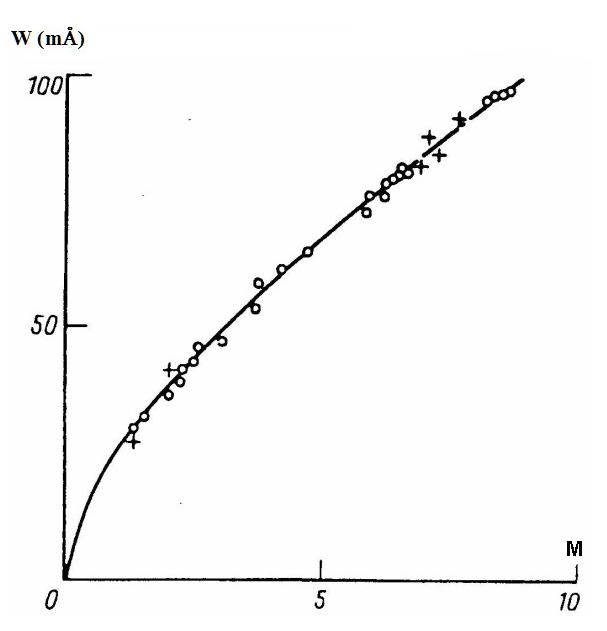 | Figure 1. Dependence of equivalent width W of the the oxygen line λ6295.178 Å on atmospheric mass M (curve of growth) |
4. Variations of the Carbon Dioxide Content
4.1. Choice of Suitable Lines CO2
- The electronic bands of the CO2 molecule are located in the ultraviolet, near λ1750 Å, and thus are inaccessible to ground-based observations. The vibration-rotation bands cover a considerable part of the spectrum from λ7600 Å to λ150,000 Å[14]. An analysis of the profiles of the CO2 lines, based on the tables in[15] and the Photometric Atlas in[16], enabled us to select two weak individual lines with "clean" (not blended by telluric and Fraunhofer lines) profiles in the λ20,800 Å region: the lines λ20,756.11 Å and λ20,758.51 Å. Unfortunately, in this region there is also a large number of irregularly spaced absorption lines due to water vapor[15]. Hence it is possible that CO2 lines selected by us can be blended with weak telluric lines of water vapor. Figure 2 shows a strip of the spectrum in the λ20,800 Å regions. Here the solid line is a spectrum found for a humidity of air of 76 %, and dashed line is the spectrum for a humidity of 23 %. From Figure 2 it follows that in the considered region there is one very strong line of water (line number 1) and some weak lines (0, 4, 5 and 8). It is obvious that CO2 lines λ20,756.11 Å (marked by 7) and λ20,758.51 Å (marked by 6) are not blended by lines of water vapor.
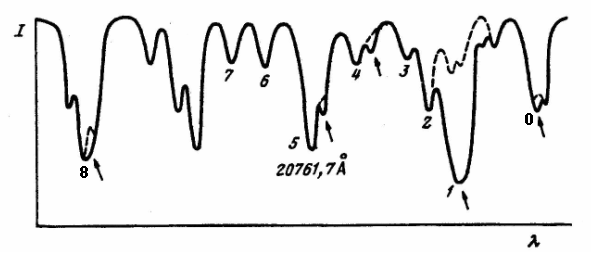 | Figure 2. Solar spectrum in the λ20,800 Å region. Solid line: humidity 76 %, dashed line: humidity 23 % (I – intensity, λ - wavelength) |
4.2. Seasonal Variations of the Carbon Dioxide Content
- A question on seasonal changes of CO2 concentration in the atmosphere is of great importance for obtaining reliable data on long-term changes of carbonic acid. According to[10], in many cities of the world the seasonal run of CO2 content is well expressed. Usually it has a minimum at the end of summer and a maximum in winter months. Apparently it occurs due to seasonal prevalence of photosynthetic activity of plants in summer and with growth of anthropogenous emissions in cities in the winter period as a result of an increase in the consumption of fuel at heating of buildings. However, appreciable deviations from this "typical" course are marked. For example, the minimum of СO2 concentration in Berlin falls on December, while in Teheran on June. The reasons of it can be features of local seasonal productivity of anthropogenous sources and geographical location of a city. We have executed researches of seasonal variations of carbon dioxide content in Moscow air basin using data of the observations obtained from February to November during 1992 - 1995. In Figure 3 the seasonal run of the optical depth τ0 in the centre of CO2 lines is presented. According to[13], τ0 is proportional to the number of CO2 molecules in all thickness of the atmosphere.
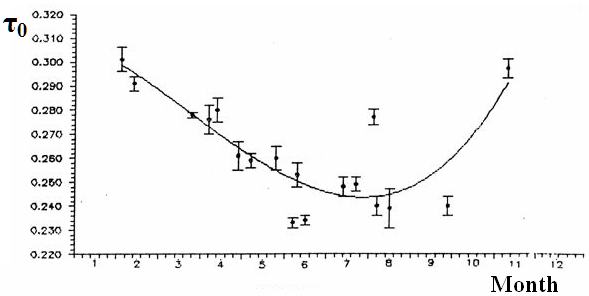 | Figure 3. The seasonal run of the optical depth τ0 in the centre of CO2 lines (points are the results of observations, continuous line is the approximating polynomial of the 3rd degree) |
4.3. A Wind and Variations of the CO2 Content
- Regular measurements of the CO2 concentration by local methods in ground layers of the atmosphere in suburbs have shown that the CO2 content grows when wind blows from the city or from the direction of powerful anthropogenous sources. A high concentration is observed also, as a rule, at a weak wind[18, 19].Since our telescope is located within the city boundaries, about 8 km to the south from its centre, the wind direction can affect the results of observations. For research of probable dependence of CO2 content on the direction of wind we have selected observations during February - November of 1992-1995. Despite considerable dispersion of points in Figure 4, it is possible to draw a conclusion that the weak dependence of measured CO2 concentration from the direction of wind is traced: for the southern wind it decreases a little and for the northern wind (from the centre of Moscow) it grows.
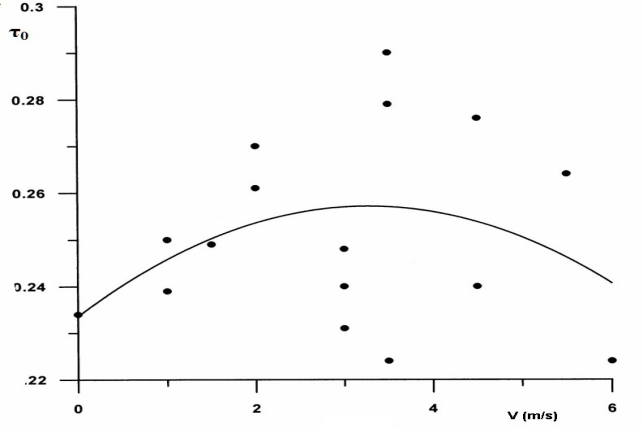 | Figure 5. The optical depth τ0 in the centre of CO2 lines versus wind speed v. The dots: observations results, solid line: r.m.sq approximation |
4.4. Long-Term Variations of the Carbon Dioxide Content
- Our first set of data of the carbon dioxide content in the air basin above Moscow were obtained on 3 December 1969 for an atmospheric mass M = 4.86 and an air temperature T = 272.8 К (-0.2°С). An average of the equivalent widths for the two lines was 252 ± 4 mÅ.The second set of the data was obtained on 27 September 1991 for atmospheric masses M from 1.88 to 12.00 at T = 292 К (19°С). The equivalent widths of the lines are plotted against the atmospheric mass in Figure 6.
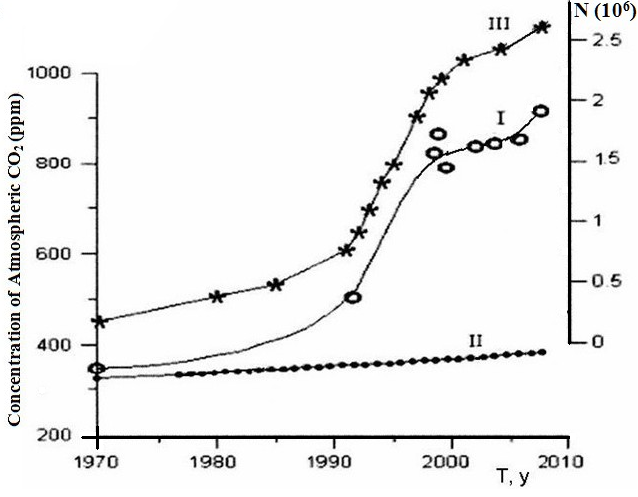 | Figure 7. Long-term variations of the CO2 content (I: observation results in Moscow air basin; II: “rural" type atmosphere[21]); III: growth of amount of vehicles in Moscow from 1969 till 2007 |
5. Conclusions
- The objective of this work is to draw attention of astronomers carrying out observations of the Sun with high spectral resolution to the possibility of using of astrophysical methods for long-term monitoring of the CO2 content in big cities. It is especially important to compare widely-spaced data (separated by at least 10 to 20 years), so as to be able to evaluate the global, possibly irreversible, changes in the composition of the atmosphere. More frequent observations at various observatories, as well as observations employing a larger number of specially selected lines, would enable to work out the general principles for a coordinate system of the constant long-term monitoring of the contents of carbonic acid in atmospheres of industrial regions.All this will allow us taking adequate measures for stabilization of the climate.Modern satellite data provide a great deal of information about the ecological state of the Earth atmosphere. Here the main difficulty consists in the quantitative interpretation of the data, especially data from filter-band observations in the visible and infrared. A ground-based astronomical system for ecological monitoring, using high-resolution observations of the Sun is less susceptible to this difficulty, so that we can thereby hope for a solution of this important metrological problem.
 Abstract
Abstract Reference
Reference Full-Text PDF
Full-Text PDF Full-Text HTML
Full-Text HTML